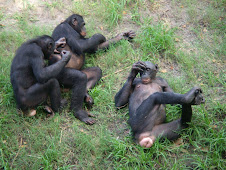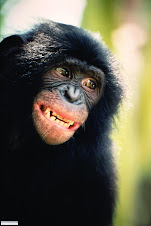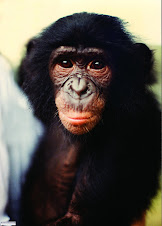
 These are cowrie shells, from a mollusk (Cypraea moneta) found in the Indian ocean. Cowries represented the first and the most widespread currency (the American dollar is a contender for the golbal title today). The trade is no longer in existence, but the items above show how cowries were used as decoration in Africa. The object is a knife sheath, and consists of two pieces of wood encased in a woven fiber envelope and studded with glass beads and cowries.
These are cowrie shells, from a mollusk (Cypraea moneta) found in the Indian ocean. Cowries represented the first and the most widespread currency (the American dollar is a contender for the golbal title today). The trade is no longer in existence, but the items above show how cowries were used as decoration in Africa. The object is a knife sheath, and consists of two pieces of wood encased in a woven fiber envelope and studded with glass beads and cowries.What makes a good currency? It needs to be portable, durable, easily divisible, difficult to counterfeit and from a limited source. Cowries met these criteria, although they were relatively heavy in bulk (in Africa, humans carried them across the continent). They are tiny and could be used as "small change" (in the 1700's, it took 25 to 32 cowrie shells to equal one farthing, the smallest currency in Britain).
There is evidence of export of cowries in the years BC, to China. The cowrie in China was so scarce that it was imitated in stone, jade, and gold. It was called "ant nose money" and used as an insert in the dead at burial, to prevent ants from entering the nostrils. Expanded export from the Maldive Islands began around the tenth century and shells were sent by the millions to Asia, Africa, and even Europe and to North America (although they were not used as money), The first cowries may have traveled as ballast in Arab dhows to the eastern coasts of Africa. In later years, the Portuguese and Dutch traded in cowries.
The Maldive Islands are a tiny country of over 1,100 islands, of which only 200 are inhabited. The total land surface of the Maldives is only one and a half times the size of the District of Columbia. The islands are located north of the Equator, south west of India.
The harvested and processing of cowries started with bundles of coconut fronds that were laid out in shallow lagoons. The rotting material collecting on the fronds attracted the mollusks to feed. Then the bundles were pulled out and spread in the sun to kill the animal inside the shells. Then, the cowries were buried in sand to decompose. Finally, the emptied shells were cleaned and shipped to foreign lands. The estimate is that there were 25 million pounds of cowries sent to the African continent between 1700 and 1800.
As other currencies, such metals coins and forged objects became popular, interest in cowries began to decline in the 18th century, although some tribes, such as the Bakuba of central Zaire (now the Democratic Republic of the Congo) appreciated the porcelain beauty of the shells. They continued to use cowries in their art, attaching them to belts, tapestries, rugs, and masks.













No comments:
Post a Comment